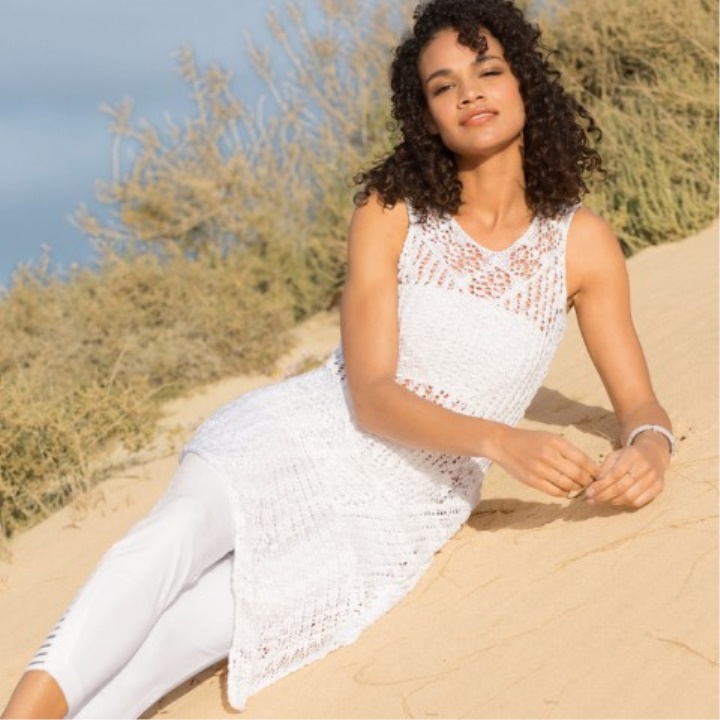The combination of negligence and luxury creates a completely new look - not only sexy, but also practical. Meet: a
, lightness and impeccability: a unique tunic is a thoughtful fashion and elite yarn with the effect of glossy and matte, as well as many elegant openwork patterns.
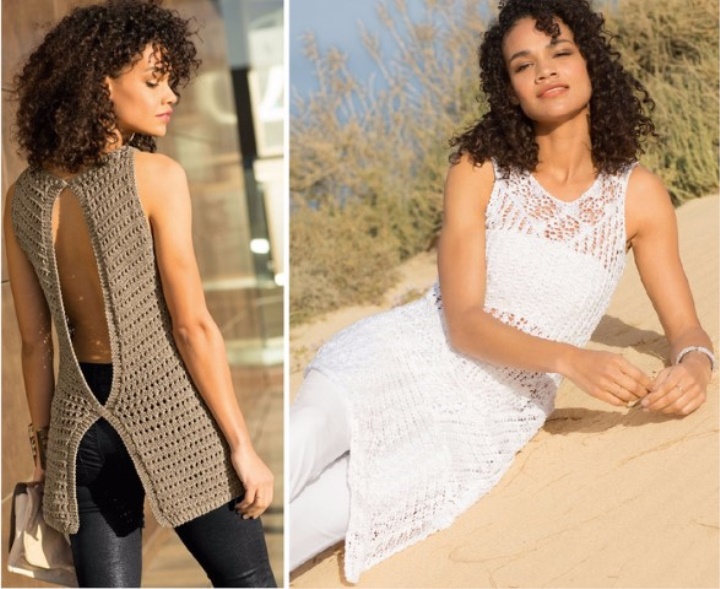
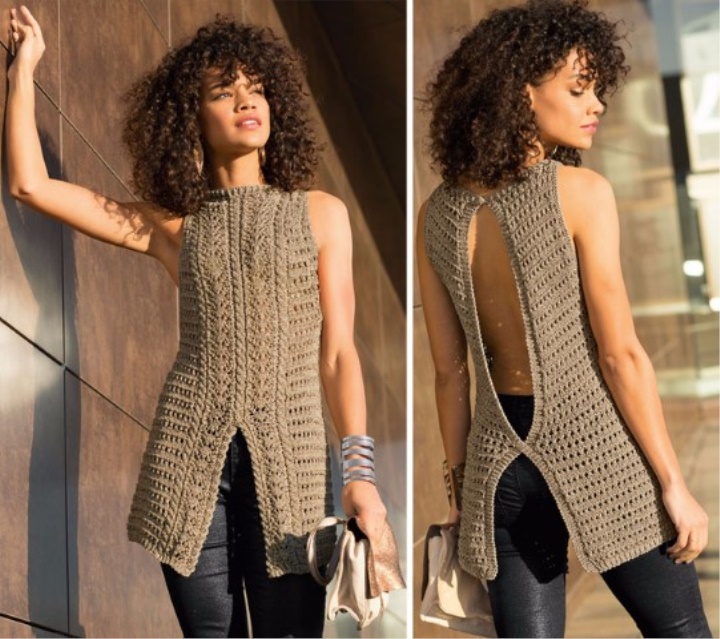
Tunic with cuts and openwork pattern.
1 (700x620, 541Kb)
The cuts and the back of this model, underlined by the slats, create a very attractive and piquant image.
DIMENSIONS
36/38 (40/42) 44/46
YOU ARE REQUIRED
Yarn (44% viscose, 34% polyester, 22% cotton, 105 m / 50 g) - 400 (450) 500 g bronze; spokes number 4,5; circular knitting needles of 60 cm in length; hook number 3; glass button.
PATTERNS AND
SCHEMES SLEEPING VISCOSE
Rows in the forward and backward direction: front and back rows - facial loops.
Circular rows: alternately 1 circular series of facial, 1 circular row of purlins.
EDITORIAL GLAX
Face rows - purl loops, purl rows - facial loops.
RUBBER
Odd number of loops.
Face series: alternately 1 facial crossed, 1 purl, 1 facial crossed.
Wrong rows: loops are to be sewn according to the drawing, while the facial crossed ones are sewn with the opposite crossed ones.
FACE GLADE
Face series - facial loops, purl rows - purl loops.
Openwork pattern
Even number of loops.
1st and 2nd rows: facial smoothness.
3 rd row: alternately 1 cape, 2 loops tie together the front.
4th row: loops and capes to be sewn with purl.
5th and 6th rows: purl loops.
Constantly repeat the 1-6th series.
Openwork pattern from "COS" A (ON 24 LOTS)
Knit acc. scheme 1. On it are given the front rows. In the back rows, all the loops are to be sewn according to the pattern, the facial crossed to be sewn with the backs of the crossed ones, and the nacs to be sewn with the purlins. Run once 1-16th series, then constantly repeat the 5-16th series.
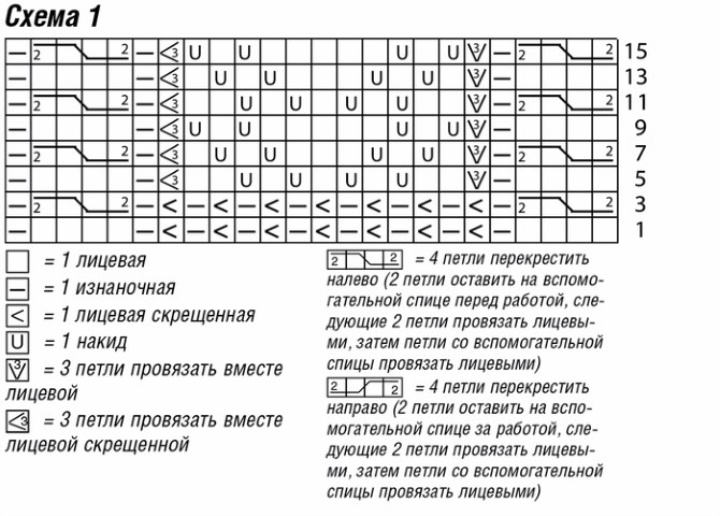
Openwork pattern from "COS" B (ON 24 LOTS)
Knit as pattern 6, but according to. scheme 2.
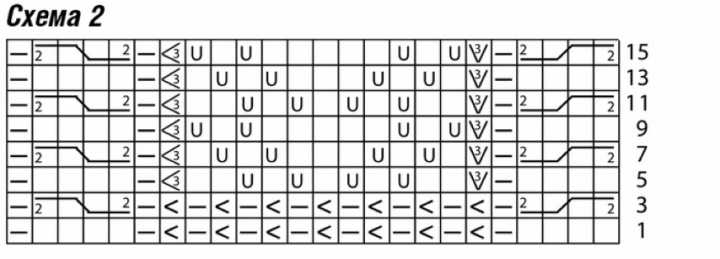
Openwork pattern from "COS" C (for 44 pts)
Knit as a pattern 6, but according to. scheme 3. Constantly repeat the 1-12th series.

DENSITY OF ADMINISTRATION
Plank with garter stitch - 4 p. = 2 cm;
18.5 p. X 30 p. = 10 x 10 cm, is connected by an openwork pattern;
30 p. X 30 p. = 10 x 10 cm, is connected by openwork patterns from the "braid";
24 p. Openwork pattern from the "braid" A or B + 1 edge = 8 cm.
ATTENTION!
For incisions, start knitting a tunic of 2 parts = left and right half of the tunic. Then, both parts to the armhole knit with a single cloth. Then, before and the details of the backrest, separate.
PERFORMANCE

EXECUTION
For the left half of the tunic, type a loop on the spokes 85 (93) 101 and knit as follows: 4 st. Garter stitch (= lath), 1 st. Purl, 55 (63) 71 stiches, 24 stitch pattern braid "A, edge.
After 1.5 cm = 4 rows from the initial row, continue working on the elastic with an openwork pattern, while in the 1st row add 1 item = 86 (94) 102 p. open the pattern with an openwork pattern 56 (64) 72 p.
After 25.5 cm = 76 rows from the initial row, leave the hinges.
The right half of the tunic is knitted in the same way, but in the mirror image, for this, start as follows: a 24-inch auburn pattern from the "braid" B, 55 (63) 71 stitches, 1 stitching, 4 st. viscous, after the increase in the loops of the elastic band on the spokes will remain 86 (94) 102 p.
After 25.5 cm = 76 rows from the initial row continue to work on both parts with a single cloth, while in the middle transfer the openwork patterns from the "braids" A and B as follows: loop the left half of the tunic to the last 6 loops according to. the last 6 loops placed on the auxiliary spoke before the first 6 loops of the right half of the tunic, then 6 loops of both halves of the tunic are bound together. pattern purl or facial acc. 1st row of scheme 3 from arrow A to B = 166 (182) 198 points.
Attention!
The average 86 (94) 102 p. Are formed before, while on the middle 44 loops knit with an openwork pattern of "braid" C, the outer 40 (44) 48 form the back parts, out of which the outer strips with 4 strips, .
After 26.5 cm = 80 rows from the initial row (see * on the pattern) cross the bars in the middle of the backrest 1 time. To do this, put the tunic in a ring, place the four loops of the strips of garter stitch on the auxiliary spoke, respectively, and apply the auxiliary knitting needles from right to left.
The next front row begins with the former last 4 stitching loops of the right half of the tunic and finish with the former first 4 loops of the left half of the tunic.
Continue the work in rows in the forward and backward direction. pattern.
For the A-shaped silhouette and subsequent ragged bevels, in the 7th row from the cross-over, 4 p., In order to do this, at the beginning of the series, bind the back loop after the garter stitching and at the end of the series the back loop before the garter plait, as well as the first and last loop openwork pattern from the "braid" C with the previous or subsequent loop together purl, respectively. These deductions are repeated 17 times in each 6th row (13 times in each 6th row and 6 times in each 4th row) 9 times in each 6th row and 12 times in each 4th row.
At the same time, after 39.5 cm = 118 rows from the initial row, divide the work for the armhole - on the spokes 146 (162) 178 loops - and for the left side of the backrest to continue working only on the first 35 (39) 43 st. pattern, leave the remaining loops. Loss after garter plucking continue.
After 65.5 cm = 196 rows from the initial row leave the remaining 22 (24) 26 n. For the neck.
The right backrest detail should be knit in the mirror image on the last 35 (39) 43 p. Then on the middle 76 (84) 92 st. Finish before acc. pattern with discounts. At the height of the backrest leave the remaining 50 (54) 58 p.
ASSEMBLY
For the neck line, take the left hinge loops on the circular knitting needles and at all 94 (102) 110 pcs between the edge band knit gum, in the 1st row, evenly distribute, 1 (3) 5 p. = 93 (99) 105 p. With a width of 2 cm, close all the hinges according to the figure.
For the armholes, dial on the circular spokes along the edges of the armhole from within 108 loops and tie 2 cm = 4 circular rows of garter stitching, starting from 1 circle series with the backs. Then close the hinges, like the purl.
At the left end of the backrest neck strap, make a buttonhole from the chain from the ap. Sew the button next to the edge on the right side of the neck.
Photo: magazine "Sabrina" №7 / 2017 Source
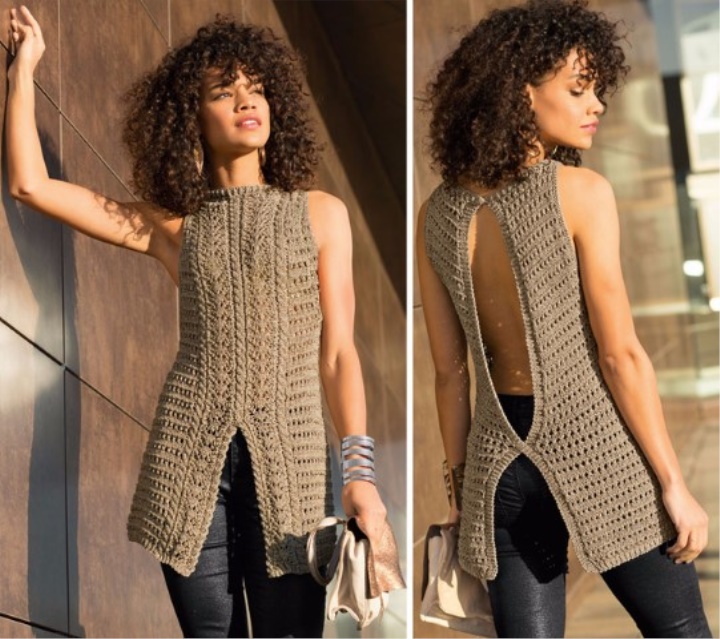
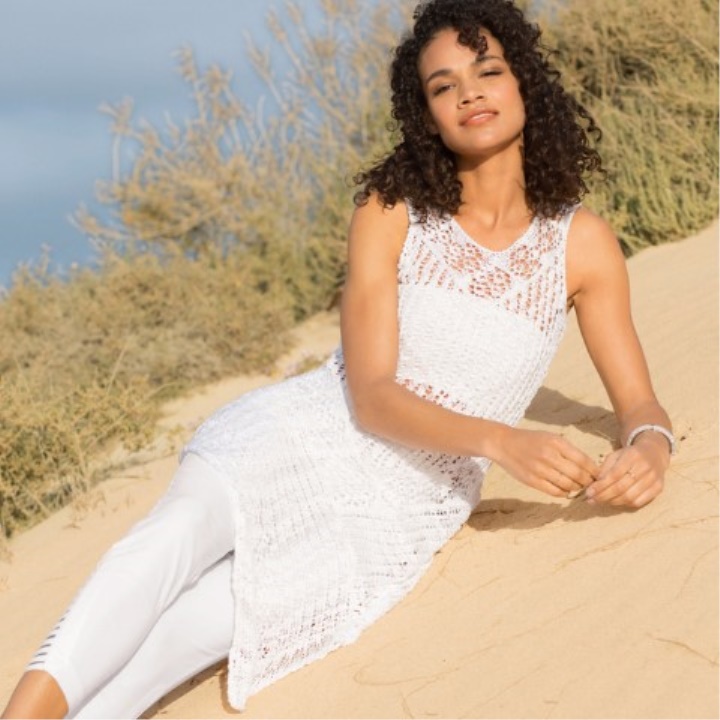
White tunic with an asymmetrical line of the bottom
10 (700x700, 593Kb)
This openwork tunic is a sample of lightness and grace. And the unusual style makes it very original.
DIMENSIONS
36/38 (40/42) 44/46
YOU ARE REQUIRED
Yarn (38% cotton, 30% polyester, 26% viscose, 6% polyamide, 160 m / 50 g) - 250 (300) 350 g white; spokes number 4; hook number 3.
PATTERNS AND SCHEMES
BASIC PATTERN (ON 97 (105) 113 PETS)
Knit cf. scheme 1. It has one face series. In the purse rows, loops and capers are to be sewn with purl. Start with 1 edge and loops before Repeat A, execute Repeat A 10 (11) 12 times, then perform 1 time 11 steps between Repeats A and B, then do Repeat B 10 (11) 12 times, end with loops after Repeat B and 1 edgeband. Constantly repeat the 1st and 2nd rows.
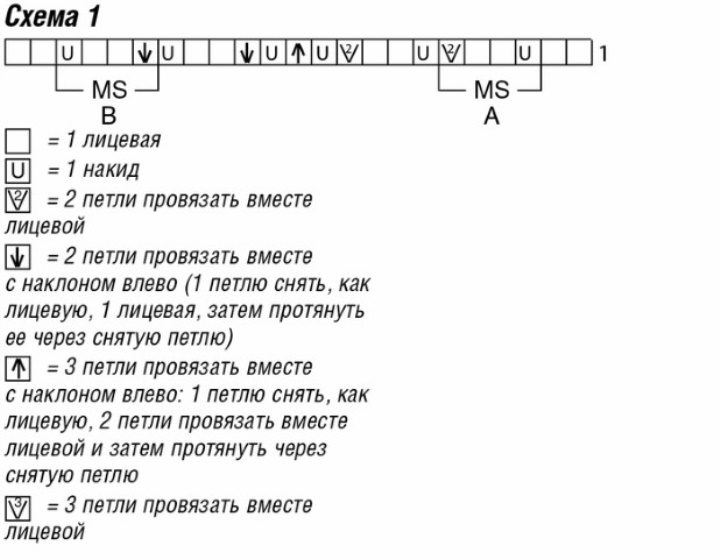
PATTERNS FROM "LEAVES" AND BOMBS (ON 13 PETS + 2 KROMOCHNYE)
Knit acc. Scheme 2, but between the edge perform only the color-coded loops. The diagram shows the front rows. In the purse rows, loops and capers are to be sewn with purl. Constantly repeat the 1-16th series.
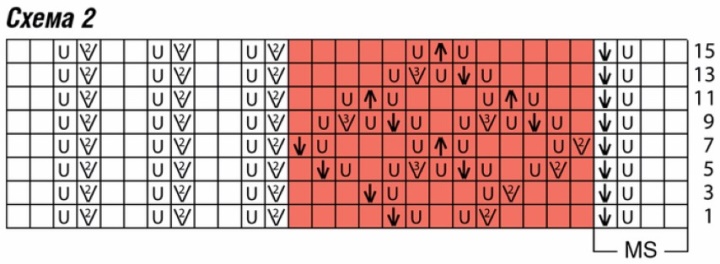
COMBINATION OF THE JAW PATTERNS (55 PETS)
Knit cf. scheme 2. Start with 1 edgeband, perform rapport 7 times, end with loops after the rapport and 1 edgeband. The diagram shows the front rows. In the purse rows, loops and capers are to be sewn with purl. Constantly repeat the 1-16th series.
DENSITY OF ADMINISTRATION
21 p. X 28 r. = 10 x 10 cm, is connected by the main pattern;
13 p. + 2 edge and 27 p. = 7 x 10 cm, connected by a pattern of "leaves";
22 p. X 28 p. = 10 x 10 cm, is associated with a combination of openwork patterns.
ATTENTION!
The angle of the line of the bottom and the V-shaped neckline on the back and front are formed due to the arrangement of the pattern. The dimensions on the pattern are partially obtained when measuring the model. Planks and Basques knit crosswise. Arrows on the pattern = direction of knitting.
PERFORMING
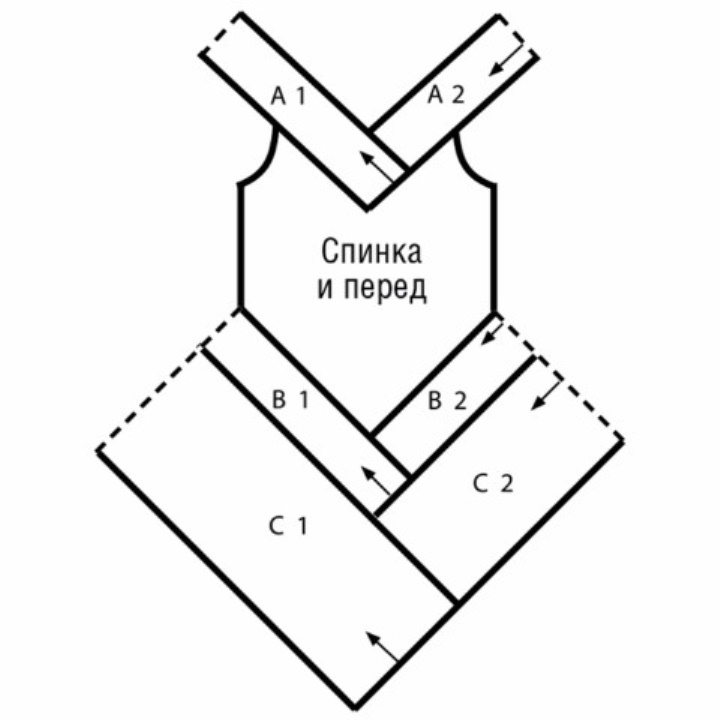
THE OPERATION OF THE
BACK
Dial 113 loops on knitting needles 97 (105) and tie 1 purl with purl; this series is not taken into account in subsequent calculations.
Continue to work with the basic pattern.
After 18.5 cm = 52 rows from the initial row, measuring along the side edge, close for the armhole on both sides 1 x 3 p., Then in each 2nd row 1 x 2 p. And 4 x 1 p. And in each 4th row 3 x 1 n.
After 27 cm = 76 rows, measuring in the middle of the gear, close the remaining 73 (81) 89 p.
BEFORE
Knit, like the back.
PROJECT PLAY (2 DETAILS)
Details A1 and A2 on the pattern. Type 15 knitting needles on the knitting needles and tie 1 purl with purl.
Continue to work with a pattern of "leaves".
After 7 (8) 9 rapports, or 41.5 cm = 112 rows (47.5 cm = 128 rows) 53.5 cm = 144 rows from the beginning row to close all the loops.
INTERMEDIATE PLANE (2 DETAILS)
Details B1 and B2 on the pattern. Type 15 knitting needles on the knitting needles and tie 1 purl with purl.
Continue to work with a pattern of "leaves".
After 8 (9) 10 rapports, or 47.5 cm = 128 rows (53.5 cm = 144 rows (59.5 cm = 160 rows) from the beginning row, close all the loops.)
BASKET (2 DETAILS) The
details C1 and C2 on type 55 knots on the spokes and tie the first purl with the wrong ones.To
continue working with a combination of openwork patterns.Through
13 (14) 15 rapports, or 74 cm = 208 rows (80 cm = 224 rows) 86 cm = 240 rows from the starting row close all hinges.
ASSEMBLY
Carry out side seams.
Detail A1 is combined with the throat angle of the gear, part A2 is combined with the angle of the neck of the backrest and sew the initial rows of parts according to. pattern to the bottom 7 cm bevel neck respectively.
Then sew the left longitudinal edge of both parts to 17.5 (19.5) 21 cm sewn to the bevel of the neck of the gear and back, respectively (see * to * on the pattern).
The following 13.5 (15.5) 18.5 cm edges should be left free for straps, the remaining 10.5 (12.5) 14 cm edges sewed to the free bevels of the neck and back (see * to * on the pattern). Closed edge acc. sew the sewing pattern to the bottom 7 cm of the adjoining part A respectively.
Detail B1 acc. The pattern is to be aligned with the angle of the bottom of the gear, detail B2 with the angle of the bottom of the back, while the right longitudinal edge is left to protrude by 6.5 cm (= to * on the pattern).
Then mark the middle of the right longitudinal edges (= • on the pattern), align them with the lateral edge and sew the edges to the beveled edges of the bottom of the gear and the back, from both sides, respectively, while prisapozhivaya.
Then, the closed edges are sewn to a ledge 6.5 cm wide, respectively.
The part C1 is to be combined with the angle of the gear, the part C2 - with the angle of the back of the parts B acc. Pattern, while the right longitudinal edge is left to protrude by 25 cm (= to • on the pattern).
Then, the remaining 49 (55) 61 cm of the longitudinal edge, slightly sprinkled, sewn to the parts B. Finally, sew the closed edges to a ledge 25 cm wide.
The edges of the neck and the armhole are tied with a crochet by a circular row of st. b / n and 1 in a circular row with a "walking step" (= item b / n to perform in the direction from left to right).
Photo: magazine "Sabrina" No. 7/2017 Source
